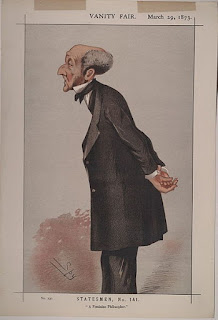During one of the Warwick Legal Network conferences, we were listening to the
speech prepared by business coach and advisor, held under the key phrase “welcome
to the new normal”. Briefly speaking it was about the rapid changes in the
legal profession which are, at least partially due to the technological shift
and on which we, the lawyers are completely unprepared. One of the speaker’s slides
presented a picture of an old man, who was supposed to represent the oldfashioned,
clumsy lawyer unable to adapt to the coming changes. The speaker was not aware
that the picture, which he picked up accidentally on Internet actually depicted
a famous British philosopher, John Stuart Mill. In 1871 he was caricatured by
Vanity Fair because of his advocacy of women’s right. Paradoxically one of the
most progressive thinkers of the XIXth century was presented as a symbol of XXIst
century business conservatism. And that was a very good symbol of the whole
speech. A lot of interesting but highly ungrounded speculations on the future
lawyer. Since then, however, I started to collect information on, how the legal
business really changes. My experience suggested that the prophesied revolution
has not come still and the legal profession is surprisingly resistant to new technologies
(it is a shame, and at this point, the blundering speaker was right). Recently, however, thanks to the manager from
Wolters Kluwer whom I met during the conference “Digital Champions” in Warsaw,
I found an extensive paper summarising the research on the possible impact of
new technologies on the legal business. In my view, it gives a sound answer to
that question[1].
Two professors did apparently a very simple thing. They checked and described
the technologies which are already applied to the legal services or which are
quite promising to be applied in the nearest future, and then set them against
the collected data on how much time do the lawyers devote to the specified
tasks. They also assessed and ranked the lawyers’ tasks according to their
susceptibility on automation, and thus their possible replacement by machines
and AI algorithms. If you think that we lawyers mainly review and draft documents,
you are wrong. Most of our time is spent on legal writing (18%), legal analysis
and strategy (27%), court appearances and preparation (14,5%) and negotiation
(5%). All those tasks are very resistant to automation. Therefore in the foreseeable
future, we can sleep relatively good. It will not be easy to replace us with
machines. The entire impact of the technology on the employment in the legal
business was estimated by the authors on 19%, that means about 2,5% annually.
The productivity growth at a rate of 2,5% p.a. is impressive but it does not
mean that a half of the legal staff will lose their jobs soon. This rather
moderate reduction of the employment will happen, providing however that the
modern technology will be adopted by law firms and that it will be legally
permissible. Both assumptions are dubious. Lawyers are extremely resistant to
new technologies and very slow at their adoption, what frustrates my interlocutor
from Wolters Kluwer, who was among other things responsible for the sale of
their computer programs for lawyers. And some of the developing solutions raise
doubts whether they should be allowed without restrictions. It especially
refers to the automatically generated legal memos, responding users’ queries
which raise problems of consumer protection. The prediction of the court
verdicts by the so-called “predictive coding” is also problematic as it may unfairly
privilege the party who disposes of that technology.
Reading the paper, I also
noticed two other unrelated issues which should concern us. One is very practical and one almost
philosophical. Although we should not be
afraid of rapid layoffs, it is worth noting that since 2007 in America the
total value of legal services provided to clients
has been stagnated or even dropping by 0,6% p.a., despite the fact that the number of lawyers has risen. It is
strange as by 2007 it was growing of about 13% annually. So what happened? It
might be the case that the Internet websites which
are already providing low-cost,
basic legal services for unsophisticated clients bite the piece of cake. It is however even more likely that there is
growing pressure from the market on
lowering the lawyers’ bills and especially on the contingency fees arrangements
instead of hourly bills. The latter is, by the way, good news for modern technology providers. One of the
indicated barriers to their adoption was an hourly rate arrangement,
which brings no incentive to increase
productivity.
The second issue is connected with a predictive coding and the possible prediction
of the court verdict. If it is deployed,
it will raise
doubts on the actual lawyers’ function in
the judicial system. The famous American legal philosopher and the judge, justice Olivier W. Holmes proposed
the account of the so-called “bad-man
perspective” which reduced the purpose of the law
and respectively the lawyers’ main task to sentence prediction. However, this simplification is not even true
in Holmes’s theory. In many of his writing,
we find the very evolutionary approach to
the law, which appears to be the engine of the social changes an thus the main
causal factor of the civilisation development. Lawyers play in it their part too.
If we exclude them from this stream, reducing their job to the proper application of the “sentence predictor”
we risk the stoppage or at least the slowdown of the social change.

